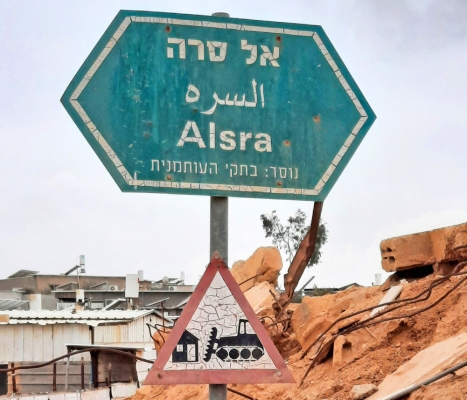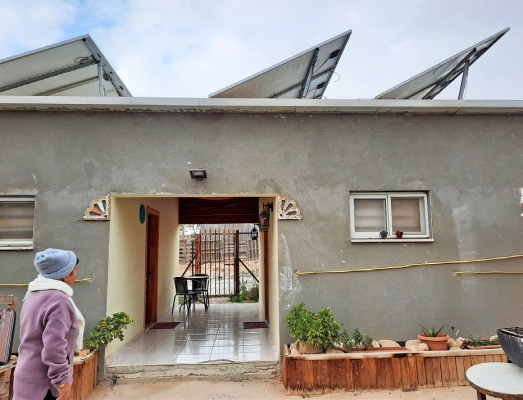Another World
Recently I took a day trip with pensioners from Nes Ziona to an area an hour away, but completely unknown. This is what was declared in 1948 ElSaig, the triangle of enclosure, an area between Beer Sheva, Arad and Dimona comprising about 10% of the area of the Negev. This area was where the Bedouin were permitted to settle following the war of independence. Our guide was Dr. Yaron Ovadia, a scholar of the Middle East and the Arab-Israeli conflict.
On the way to the first of two unrecognized villages, Alsira, Dr. Ovadia gave us a brief history. A British census in 1946 counted around 80,000 Bedouin in the Negev. Most left or were expelled to Jordan and some to Egypt during the war, but 11,000 remained. They were resettled with their herds in the triangle of enclosure. Thus began the 'Bedouin problem'. Previously, the 17 different tribes had the use of 8 million dunams of land. There had been 6 tribes resident in the triangle and now there were added 11 other tribes. There was not enough pasture for the herds, and there were few employment opportunities for the families.
In addition to the Bedouin tribes there were two additional populations. One is Fellahin, farmers who came to the area in the 19th and 20th century when the Bedouin began to do some farming. Since the Bedouin were herders or traders, they recruited Fellahin to be tenant farmers on land that they held. In turn during this time there was migration of poor people from Sudan northward and some of them reached Israel and became indentured to the Fellahin and the Bedouin. All of these groups became Israeli citizens after the establishment of Israel, although they were under Israeli military government until the mid 1960s.
In 1963 the government began a program to build towns for the Bedouin. The first was Tel Sheva in 1969, while Rahat was founded in 1972. Altogether 7 towns were built, and over the years another 11 villages were recognized. When the towns were planned, the Bedouin could receive a plot for free to build a family home. However, they had to sign a document saying that they had no claims on any land elsewhere in Israel. The Fellahin and the people from the Sudan could sign such a document, but many Bedouin had grazing land from the time of the Ottomans elsewhere in the Negev (even if they could presently not access it), and they would not relinquish this. Therefore, the people moving into the towns were from the poorer sections of the Bedouin society. The Jewish villages in the triangle, Lehavim (established 1983), Meitar (established 1984), Omer (established 1974) and Carmit (established 2010), are on a socio-economic level of 9/10, while Lakiya (established 1985), Rahat (established 1972) and Hura (established 1989) are on the lowest socio-economic level of 1.
The Bedouins with land in the Negev do not have a 'Tabu' for the property, but do have 'Hakira' from the Ottoman time. The government tried to say that this is not legally binding. However, both before and after the establishment of Israel, the Jewish Agency (Keren Kayamet) had bought land from the Bedouins in order to establish Jewish settlements in the Negev. Therefore, the Bedouins are adamant that they have legal right to the land that they claim and need to be compensated.
This was the background we were given as we reached the town of Alsira and met Khalil. He had been an educator before retiring and becoming an advocate in the struggle to get his community recognized. He showed us around the settlement and his house, which includes two tzimmerim for desert hospitality (shown on Google maps as Khan Alsira), and a large tent heated with a wood stove where we spoke with him. He explained that in 1921 his grandfather bought the land from other Bedouins and 4 members of his family settled there with their families. From these 4 families there are currently 75 families. The community is not recognized by the government. Therefore, there are no services, such as paved roads, street lighting, electricity, water or garbage collection. However, the children are bussed to school. Water is brought by a pipe from the recognized town of Kseifa, 10 km away. Electricity is from solar panels with battery storage, although before solar panels arrived some had generators and some had no electricity. Garbage is a problem. They dispose of their garbage in pits dug by the residents, and try to keep waste at a minimum. But from the trash along the roads this is a huge problem in all the villages in the area. He has a 'Hakira' for the land and is trying to get recognition for the village.
Our second visit was to a recognized school, Neve Midbar, in an unrecognized village, Abu Kwaider. The village is populated by a tribe of Fellahin who came to Israel about 200 years ago. The principal, Hader, is from the village. He began as a young teacher when the school was established in the mid-1990s. At the beginning there was no electricity. The government did not want to connect the school to the grid because they feared that the village would also use the lines. After going to court the school was given a generator, which was more expensive than electricity from a power line and which often was broken. Electricity was only installed 4 years ago, while the village relies on solar power.
The school is a model school, from first to eighth grade. It is clean, the classrooms are quiet, the teachers and principal have added things like a space center, a dance studio, a mediation room, a handicrafts studio and a recycling center. Hader is proud of the dance studio which he added because the girls could not do sports like the boys and he wanted some exercise for them. Parents were initially reluctant, but after the first year he invited them for an evening to see what the girls learned and they were won over. There is a long school day, and the children are given hot lunches. Dr. Yaron Ovidia told us that Hader has been nominated for a prize for excellence by the Ministry of Education.
Our visit ended on a high note with the visit to the Neve Midbar school. We learned that the story of the Bedouin in Israel is a complicated one. In addition to the problem of land and unrecognized villages, there are other aspects. These include the conservativeness of the Bedouin society, including the continuation of tribal identity, the presence of polygamy, the status of women in the society, the influence of the Moslem Brotherhood, and violence in the towns. But it is important to recognize the complexity and work to find equitable solutions. The first towns were built with little or no input from the Bedouins themselves. The Bedouins are beginning to find a voice, and the government is beginning to listen. Hopefully, the graduates of Neve Midbar will go on to be successful members of both Bedouin and Israeli society.









Comments